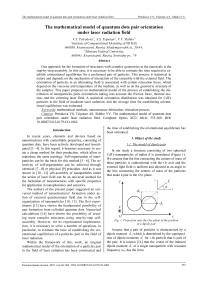The mathematical model of quantum dots pair orientation under laser radiation field
Автор: Petrakova Viktoriya Sergeevna, Tsipotan Alexey Sergeevich, Slabko Vitaly Vasilievich
Журнал: Компьютерная оптика @computer-optics
Рубрика: Дифракционная оптика, оптические технологии
Статья в выпуске: 4 т.46, 2022 года.
Бесплатный доступ
One approach for the formation of structures with complex geometries at the nanoscale is the step-by-step assembly. In this case, it is necessary to be able to estimate the time required to establish orientational equilibrium for a preformed pair of particles. This process is statistical in nature and depends on the mechanism of interaction of the ensemble with the external field. The orientation of particles in an alternating field is associated with certain relaxation times, which depend on the viscosity and temperature of the medium, as well as on the geometric structure of the samples. This paper proposes an mathematical model of the process of establishing the distribution of nanoparticles pairs orientations taking into account the friction force, thermal motion, and the orienting laser field. A statistical orientation distribution was obtained for CdTe particles in the field of moderate laser radiation, and the average time for establishing orientational equilibrium was estimated.
Mathematical methods, nanostructure fabrication, relaxation process
Короткий адрес: https://sciup.org/140295010
IDR: 140295010 | DOI: 10.18287/2412-6179-CO-1062
Список литературы The mathematical model of quantum dots pair orientation under laser radiation field
- Grillot F, Duan J, Dong B, Huang H. Uncovering recent progress in nanostructured light-emitters for information and communication technologies. Light Sci Appl 2021; 10(1): 156. DOI: 10.1038/s41377-021-00598-3.
- Zheng F, Liu Y, Ren W, Sunli Z, Xie X, Cui Y, Hao Y. Application of quantum dots in perovskite solar cells. Nanotechnology 2021; 32(48): 482003. DOI: 10.1088/1361-6528/abead9.
- Li T, Li Z, Huang T, Tian L. Carbon quantum dot-based sensors for food safety. Sens Actuator A Phys 2021; 331: 113003. DOI: 10.1016/j.sna.2021.113003.
- Li N, Mahalingavelar P, Vella JH, Leem D-S, Azoulay JD, Ng TN. Solution-processable infrared photodetectors: Materials, device physics, and applications. Mater Sci Eng R Rep 2021; 146: 100643. DOI: 10.1016/j.mser.2021.100643.
- Xiao J, Qi L. Controllable self-assembly of gold nanorods via host-guest interaction between cyclodextrins and surfactants. Acta Physico-Chimica Sinica 2020; 36(10): 1910001. DOI: 10.3866/PKU.WHXB201910001.
- Roy B, Arya M, Thomas P, Jurgschat JK, Rao KV, Banerjee A, Reddy CM, Roy S. Self-assembly of mesoscopic materials to form controlled and continuous patterns by thermo-optically manipulated laser induced mi-crobubbles. Langmuir 2013; 29(47): 14733-14742. DOI: 10.1021/la402777e.
- Tikhomirov G, Hoogland S, Lee PE, Fischer A, Sargent EH, Kelley SO. DNA-based programming of quantum dot valency, self-assembly and luminescence. Nat Nanotechnol 2011; 6: 485-490. DOI: 10.1038/nnano.2011.100.
- Zhang Y, Tu J, Wang D, Zhu H, Maity SK, Qu X, Bogaert B, Pei H, Zhang H. Programmable and multifunctional DNA-based materials for biomedical applications. Adv Mater 2018; 30(24): 1703658. DOI: 10.1002/adma.201703658.
- Wang T, LaMontagne D, Lynch J, Zhuangc J, Cao YC. Colloidal superparticles from nanoparticle assembly. Chem Soc Rev 2013; 42(7): 2804-2823. DOI: 10.1039/C2CS35318K.
- Slabko VV, Khachatryan GG, Aleksandrovsky AS. Self-organized aggregation of small metal particles controlled by an external light field. JETP Lett 2oo6; 84(6): 3oo-3o4. DOI: 1o.1134/Soo21364oo618oo56.
- Slabko VV, Tsipotan AS, Aleksandrovsky AS. Resonant light-controlled self-assembly of ordered nanostructures. Photonics Nanostruct 2o12; 1o(4): 636-643. DOI: 1o.1o16/j.photonics.2o12.o6.oo2.
- Tkachenko VA, Tsipotan AS, Aleksandrovsky AS, Slabko VV. Three-dimensional model of quantum dots' self-assembly under the action of laser radiation. Computer Optics 2o17; 41(4): 577-58o. DOI: 1o.18287/2412-6179-2o17-41-4-577-58o.
- Tsipotan AS, Gerasimova MA, Slabko VV, Aleksandrov-sky AS. Laser-induced wavelength-controlled self-assembly of colloidal quasi-resonant quantum dots. Opt Express 2o16; 24(1o): 11145-1115o. DOI: 1o.1364/OE.24.o11145.
- Kornienko VS, Tsipotan AS, Aleksandrovsky AS, Slabko VV. Brownian dynamics of the self-assembly of complex nanostructures in the field of quasi-resonant laser radiation. Photonics Nanostruct 2o19; 35: 1oo7o7. DOI: 1o.1o16/j.photonics.2o19.1oo7o7.
- Goldstein H. Classical mechanics. 2nd ed. Reading, MA: Addison-Wesley Pub Co; 198o.
- London F. The general theory of molecular forces. Trans Faraday Soc 1937; 33: 8-26. DOI: 1o.1o39/tf93733ooo8b.
- Baracu T, Grigoras-Benescu S. Computational analysis of the flow around a cylinder and of the drag force. 2nd Conf of the Young Researchers from TUCEB. At: Technical University of Civil Engineering of Bucharest, Romania; 2o11.
- Butcher JC. On the implementation of implicit Runge-Kutta methods. BIT Numer Math 1976; 16(3): 237-24o. DOI: 1o.1oo7/BFo1932265.


